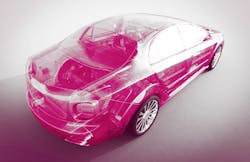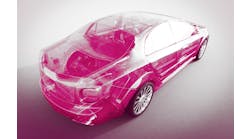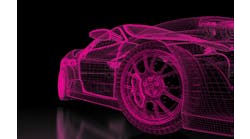NASHVILLE, TENN., Dec. 7, 2021—Over the last several years, the use of and references to ADAS—advanced driver assistance systems—has grown at an exponential rate.
More and more, vehicles are equipped with sensors, cameras and other tools to help drivers stay safe on the roads, and those vehicles are now entering shops with increasing frequency.
Because of that ubiquity and the amount of technology that is classified as ADAS, however, it has become difficult to succinctly define what ADAS means.
“ADAS is not a ‘thing, it’s an industry generated collection of features that help the driver. Cruise control is a driver assist system; making it radar-responsive makes it advanced,” Ben Johnson, director of product management at Mitchell 1, said. “When people design a new system, they don’t decide ‘oh, hey, this is going to be a part of ADAS.’ It’s hard to find one category to put everything into.”
Camera and sensor layouts vary widely between OEMs and even between vehicles from the same manufacturer, and each of those components can be used for more than just one ADAS function. For example, sensors in a vehicle’s front bumper can be used for auto lane keep, adaptive cruise control, emergency stop warnings and so on.
With those systems becoming prevalent throughout the industry, some have lamented that ADAS will be the end of the repair industry as we know it.
Jason Ziese, mechanical operations manager at LaMettry’s Collision, doesn’t see it that way.
“Severity of crashes has gone down, but the cost of repairs have gone up. People have been practicing really bad driving habits for the last year and a half,” Ziese said. “Because of that, we’re going to have an extended time of a lot of crashed cars.”
That means your shop has already, most likely, seen an ADAS-equipped vehicle, and if it hasn’t, it’s almost guaranteed to happen in the not-too-distant future. Instead of ignoring it or actively wishing it weren’t here, Johnson says your shop needs to be actively training and preparing for working on ADAS.
“Collision has embraced this a lot more than mechanical. If you’re doing basic repair—radiators, windshields, so on—you’re working on ADAS,” Johnson said. “People don’t seem to fully understand it.”
There isn’t really a one-stop shop to learn about everything ADAS—as mentioned earlier, OEMs vary greatly in their use and deployment of cameras and sensors. Because of that, biting the bullet and researching specific vehicle models as they come in is the best way to get up-to-date on the technology your techs will be working with.
“Keeping things updated is so crucial, both your tools and your techs. Making sure people are actually understanding a vehicle instead of just trying the same thing over and over again is so crucial,” Ziese said. “Our staff takes pride in what they’re doing, their equipment and their service. It comes down to having the right people.
“Customers want those features and they enjoy those features. When doing even the simplest repairs, if the procedures call for a recalibration, do it. We can’t afford to take that liability. You have to be able to explain to your customer what the system is, how it works and why it’s necessary to do the scan when fixing their vehicle.”
ADAS is an ever-evolving art of the industry, and shops need to be prepared to make a recurring investment in both technology and training to make sure they stay ahead of the curve.
“Everybody is learning this as they go. Even the companies that build these systems for the OEs are learning as they go,” Johnson said. “You’ve got a couple of choices as a shop to start getting in. No. 1) invest in the equipment you need if you’re working on enough vehicles. No. 2) if you aren’t, find someone who has a facility and refer your customer to them.”
Regardless of how a shop decides to handle it, LaMettry’s President of Operations Darrell Amberson says it’s a step every shop should take.
“It’s time for us as an industry to take the next step up, to think more highly of ourselves, to take on more responsibility and gain more trust of the customer,” Amberson said. “We are at a point where we deserve and should demand more respect.”


